Services
– Reservations-Required
Suspension of Self-Service
Instrument Access
Nearly all of these instruments are accessed
Client PC Workstation
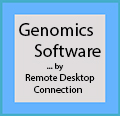 Advance Reservations, made through the Biosci-Booked (Genomics), are required for use of this computational resource (Computer-Workstation.jpg) in the LSU Genomics Core. The computer has a variety of genomics-related software (see List) with associated User Guides, as well as standard Microsoft Office software, some Adobe products, and utility programs. For descriptions of some of the ABI software, please see Data Analysis on the 'Services' page for the ABI 3130xl platform. Suggestions for additional 'genomics' software are welcome.
Advance Reservations, made through the Biosci-Booked (Genomics), are required for use of this computational resource (Computer-Workstation.jpg) in the LSU Genomics Core. The computer has a variety of genomics-related software (see List) with associated User Guides, as well as standard Microsoft Office software, some Adobe products, and utility programs. For descriptions of some of the ABI software, please see Data Analysis on the 'Services' page for the ABI 3130xl platform. Suggestions for additional 'genomics' software are welcome.
Clients may use this computational resource by Remote Desktop (computer name: lsa-628-client), and that access requires that you have:
When using the Client Workstation PC, you must:
Accuris
 [Entry in Progress - 24Jan2005] Advance Reservations, made through the Biosci-Booked (Genomics) [in progress], are required for use of this instrument (Accuris Series Tx.jpg) in the Genomics Core. The Accuris Series Tx provides a fast, practical way to verify that a pipette is dispensing accurately.
[Entry in Progress - 24Jan2005] Advance Reservations, made through the Biosci-Booked (Genomics) [in progress], are required for use of this instrument (Accuris Series Tx.jpg) in the Genomics Core. The Accuris Series Tx provides a fast, practical way to verify that a pipette is dispensing accurately.
Thus, you can both quickly verify your pipette's performance and know when you really need to have your pipettes re-calibrated.
You may also request that the Genomics Core check the performance of your pipettes on the Accuris Series Tx platform (see GC Services, Accuris Series Tx [in progress]).
QuantStudio·6 (qPCR)

Advance Reservations, made through the Biosci-Booked (Genomics) instrument reservation system, are required for use of this instrument. For a complete guide to qPCR experiments, see ThermoFisher's Real-time PCR Handbook 2.0 (2024; periodically updated).
– For various reasons, samples might be processed later than specified in your reservation; if this is an issue for your experiment, consult with Scott ahead of time.
– For time-sensitive samples, ensure that Scott will be able to process them within the required time-frame before you prepare the samples for submittal.
Our QuantStudio·6 is calibrated for FAM, NED, TAMRA, VIC, ROX, and SYBR. It can be calibrated for other dyes, but you would need to supply the calibration plate.
Thus, if you choose to use non-ABI 'plastics', best practice is to first run at least one test plate in which all 96-wells contain just nuclease-free water. This is not the same as having actually calibrated the qPCR platform with your choice of 'plastics', but it should give you a good idea as to whether your 'plastics' are at least compatible with the instrument's calibrations.
– Upon first use of software:
(1) Click 'Tools', 'Preferences', & 'Default'; select default instrument and 96-well standard block... and click 'Ok'.
(2) You can also click the box for 'Show optical filters for run method'; this will add a second tab ('Optical Filters') to the Run Method screen under Experiment Setup. However, in most cases, you should not change the filters that are selected by default for your experiment type as doing so will limit your ability to correct Setup errors following completion of the run.
– Setup Page notes:
(1) Experiment Properties tab: The Experiment Name
(2) Define tab: If your qPCR master-mix contains a Passive Reference dye, selecting it on the Define tab will improve your data quality. Typically, the Passive Reference dye will be ROX. If you mistakenly left the default value (i.e., None) for the Passive Reference, you can edit your Setup in the completed Run file, and reanalyze the run with the proper selection (see example).
– Submit run files (*.eds) by email, Genomics Core; completed run files will be returned to you by email.
Such contamination can be transferred to the block of the qPCR machine, adversely affecting your experiment and subsequent experiments until the block contamination is discovered and laboriously removed.
Thus, your new plate
Thus, for "cold-reaction" setup, best practice is to use a dedicated metal block (chilled) for 96-well PCR-plates or a dedicated insulated container filled with clean ceramic or glass beads. If reactions are set up on ice, the plate must be centrifuged either immediately after being removed from the ice or after being briefly soaked in clean water.
Finally, prolonged setup times with a chilled plate can result in atmospheric water condensing in the wells, thereby altering reaction volumes and ultimately your results. This problem can be severe under high humidity conditions (e.g., building A/C is not at normal capacity). One option is to cover the plate with a "cap" whenever not actively pipetting into the plate.
It is also important to avoid touching the surface of the adhesive film as oils and other substances could affect its optical qualities or even fluoresce. Similarly, your applicator paddle must be clean. However, ethanol has its own fluorescent properties; thus, if you remove potential oils with ethanol, you need to thoroughly rinse the paddle with purified water and dry it with a Kimwipe.
Finally, it is critical that you do not leave any sticky residue on the plate after removing the 'wings' from the adhesive film. Such residue can cause the plate to bond with the heated cover plate, making it difficult for the instrument to disengage from the plate.
Veriti thermal cycler
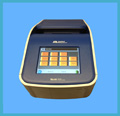 Advance Reservations, made through the Biosci-Booked (Genomics) instrument reservation system, are required for use of the Veriti thermocycler (located to the right of the qPCR platforms). This thermocycler performs standard PCR, including temperature gradients, and it is protected from brief power outages by an APC backup power supply. Normally, all other thermocyclers in the Genomics Core are reserved solely for use by the Core or members of the Batzer lab; however, you may request permission to use the other thermocyclers if you can plead extenuating circumstances.
Advance Reservations, made through the Biosci-Booked (Genomics) instrument reservation system, are required for use of the Veriti thermocycler (located to the right of the qPCR platforms). This thermocycler performs standard PCR, including temperature gradients, and it is protected from brief power outages by an APC backup power supply. Normally, all other thermocyclers in the Genomics Core are reserved solely for use by the Core or members of the Batzer lab; however, you may request permission to use the other thermocyclers if you can plead extenuating circumstances.
Qubit 4.0
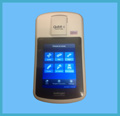
If using your own assay kits, this fluorometer (Qubit-4.0.jpg) is available for use directly by you through the Biosci-Booked (Genomics) reservation system. Otherwise, samples are processed by the Genomics Core as described at the "Services" link below.
There are many Qubit assays available from ThermoFisher. Assays require 1-20 ul of sample, resulting in the quantitation ranges shown with each kit. Samples are analyzed using Axygen 0.5-ml tubes (PCR-05-C, thin-wall, clear).
RNA IQ assay: In combination with the Qubit 4.0, this assay accurately distinguishes intact from degraded RNA by using two unique dyes: one that binds to large, intact RNA, and another that selectively binds to small, degraded RNA. Results are provided as an
Diagenode Bioruptor NGS
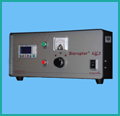 Advance Reservations, made through the Biosci-Booked (Genomics) instrument reservation system, are required for use of this instrument. Further, prior to each use of the Bioruptor, clients must ask the Genomics Core staff to prepare the system for operation. Staff will also provide instructions for operation of the Bioruptor, guidance on sonication profiles, and empty the system after use.
Advance Reservations, made through the Biosci-Booked (Genomics) instrument reservation system, are required for use of this instrument. Further, prior to each use of the Bioruptor, clients must ask the Genomics Core staff to prepare the system for operation. Staff will also provide instructions for operation of the Bioruptor, guidance on sonication profiles, and empty the system after use.
To retain the integrity of DNA, Diagenode’s Bioruptor® NGS uses a gentle method of sonication and a chilled water bath to generate indirect sonication waves. As a result, the Bioruptor® produces better and more consistent results than are achieved with harsher sonication methods. Up to 12 closed tubes can be sonicated in parallel and the continuous rotation of tubes allows even distribution of the energy for efficient sonication.
ThermoFisher SPD1010 SpeedVac
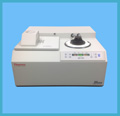 Advance Reservations, made through the Biosci-Booked (Genomics)
instrument reservation system, are required for use of this instrument. This ThermoFisher instrument (SPD1010 SpeedVac.jpg) efficiently processes large batches of DNA or RNA samples.
Advance Reservations, made through the Biosci-Booked (Genomics)
instrument reservation system, are required for use of this instrument. This ThermoFisher instrument (SPD1010 SpeedVac.jpg) efficiently processes large batches of DNA or RNA samples.
Currently, we have rotors for microtubes (1.5-ml, or 0.2-ml with inserts) and for 96-well plates. Typical applications include concentrating DNA extractions and removing low concentrations of non-agressive organic solvents (methanol, ethanol, acetonitrile) from samples. Most samples can be processed by simply pressing the "Start" button; however, users may also adjust settings for vacuum pressure, temperature, and run time.
Typhoon 8600 Variable Mode Imager
 Advance Reservations, made through the Biosci-Booked (Genomics) instrument reservation system, are required for use of this instrument. The Typhoon™ 8600 Variable Mode Imager is primarily used for storage phosphor experiments, but it is also capable of fluorescence detection of gels and blots. For DNA, RNA, and protein samples, users can choose from storage phosphor autoradiography, direct green (532 nm) excited fluorescence, and direct red (633 nm) excited fluorescence. The Typhoon can scan storage phosphor screens (mounted or unmounted), gels and blots (≤ 35 × 43 cm); further, images can be manipulated with ImageQuant™ Image Analysis Software.
Advance Reservations, made through the Biosci-Booked (Genomics) instrument reservation system, are required for use of this instrument. The Typhoon™ 8600 Variable Mode Imager is primarily used for storage phosphor experiments, but it is also capable of fluorescence detection of gels and blots. For DNA, RNA, and protein samples, users can choose from storage phosphor autoradiography, direct green (532 nm) excited fluorescence, and direct red (633 nm) excited fluorescence. The Typhoon can scan storage phosphor screens (mounted or unmounted), gels and blots (≤ 35 × 43 cm); further, images can be manipulated with ImageQuant™ Image Analysis Software.
Eppendorf Centrifuge 5810R
 At this time, we do not require reservations for this instrument. The Eppendorf 5810R Centrifuge is a refrigerated unit (-9 to 40°C), capable of handling
both large tubes and microtiter plates. Maximum speed is ~2800 rcf, and a soft acceleration-
deceleration option is available. The Genomics Core has the
A-4-62 rotor, which sports two types of adaptors: (A) microtiter plates or 96-well PCR plates;
and, (B) 15-ml or 50-ml tubes (with correct inserts). Other rotors could be obtained if there
is sufficient interest.
At this time, we do not require reservations for this instrument. The Eppendorf 5810R Centrifuge is a refrigerated unit (-9 to 40°C), capable of handling
both large tubes and microtiter plates. Maximum speed is ~2800 rcf, and a soft acceleration-
deceleration option is available. The Genomics Core has the
A-4-62 rotor, which sports two types of adaptors: (A) microtiter plates or 96-well PCR plates;
and, (B) 15-ml or 50-ml tubes (with correct inserts). Other rotors could be obtained if there
is sufficient interest.

